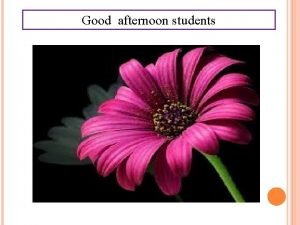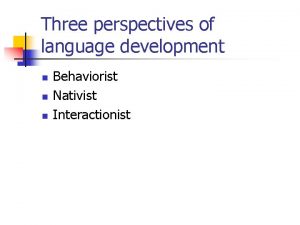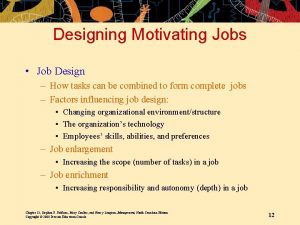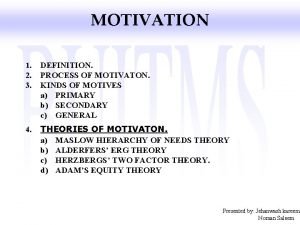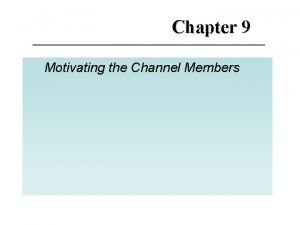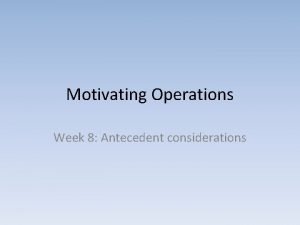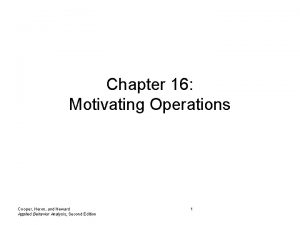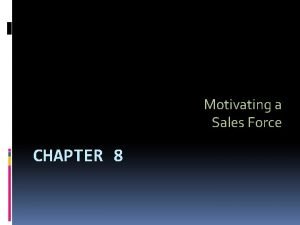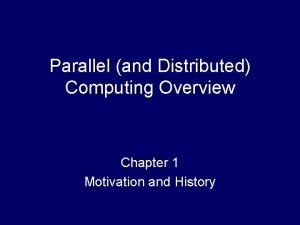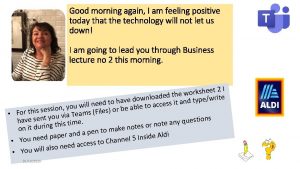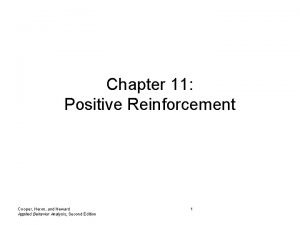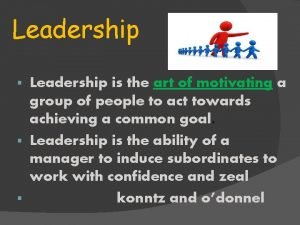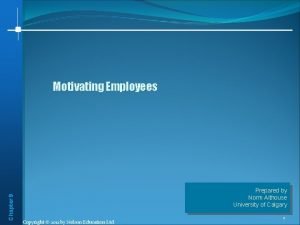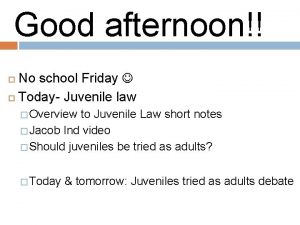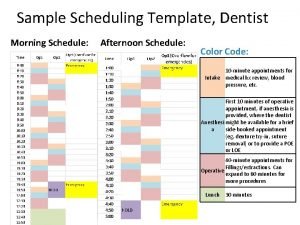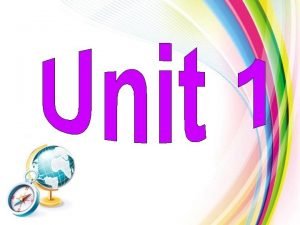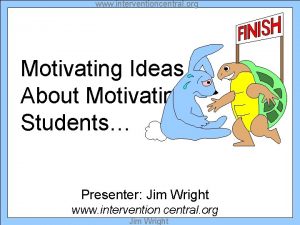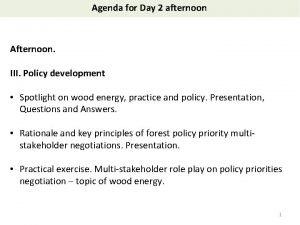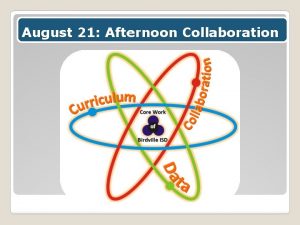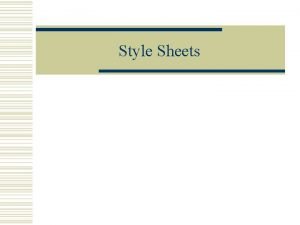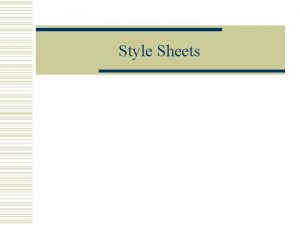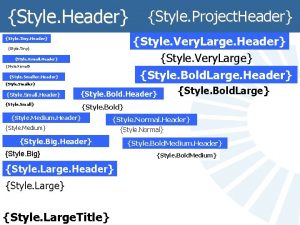Motivating Students Afternoon Workshop A Teachers Motivating Style






































































- Slides: 70

Motivating Students Afternoon Workshop

A Teacher’s Motivating Style Affects Students’ Need States Source: Cheon, S. H. , Reeve, J. , Lee, Y. , Ntoumanis, N. , Gillet, N. , Kim, B. R. , & Song, Y. -G. (in press). Expanding autonomy psychological need states from two (satisfaction, frustration) to three (dissatisfaction): A classroom-based intervention study. Journal of Educational Psychology. http: //dx. doi. org/10. 1037/edu 0000306.

Interests, Intrinsic Motivation Students walk into each class with a full repertoire of engagement-fostering motivational resources Psychological Needs • Autonomy • Competence • Relatedness Intrinsic Goals Self-Endorsed Values

The Interpersonal Tone that Becomes the Teacher’s Motivating Style Autonomy Support Teacher Control Tone: UNDERSTANDING Tone: PRESSURE “I am your ally. I am here to support you and your strivings. ” “I am your boss. I am here to socialize and to change you. ” Perspective Taking Acknowledge Feelings Support Display Initiatives Patience Vitalize IMRs • • • Support autonomy Support competence Support relatedness Informational Language Prescriptives Introduce Extrinsic Motivators Display Impatience Counter/Change Feelings Pressuring Language

How Do I Become More Autonomy Supportive? Two Basic Motivational Problems Developing the 4 Teaching Skills You Need to Solve These Two Basic Motivational Problems

Two Basic Motivational Problems for Teachers to Solve How do I encourage students’ classroom engagement? • How do I support intrinsic motivation? • How do I offer students interesting learning activities? How do I encourage students’ behavioral change? • How to I support internalization? • How do I help students develop the motivation, initiative, and skill they need for more competent functioning (e. g. , prosocial behavior, self-regulation)?

Two Basic Motivational Problems for Teachers to Solve How do I encourage students’ classroom engagement? • How do I support intrinsic motivation? • How do I offer students interesting learning activities? How do I encourage students’ behavioral change? • How to I support internalization? • How do I help students develop the motivation, initiative, and skill they need for more competent functioning (e. g. , prosocial behavior, self-regulation)? If students believe the learning task is interesting, important, or both, you won’t have motivational problems in your classroom.

Four Needed Teaching Skills 1 2 3 But the benefit is not so much in being able to enact each individual supportive behavior but, rather, in being able to offer students an overall coherent supportive motivating style.

A Fourth Teaching Skill to Work on: Diminishing a Controlling Motivating Style Become More Autonomy Supportive 4 AND Become Less Controlling

Conceptual Definitions of 6 Autonomy-Supportive Instructional Behaviors Take the students’ perspective The teacher’s perceiving and experiencing as if he or she were the students. Teacher imagines himself or herself to be the students. Teacher shows mindfulness about the students’ needs, wants, goals, priorities, preferences, and emotionality. Vitalize psychological needs Using instruction as an opportunity to awaken (involve) and nurture (satisfy) students’ interests, psychological needs for autonomy, competence, and relatedness, and intrinsic goals. Teacher involves the students’ otherwise dormant inner motivational resources to make them (e. g. , an experience of autonomy) a central part of the learning activity. Provide explanatory Rationales Verbal explanations to help students understand why self-regulation of the activity would have personal utility. Explanations to help students transform something not worth doing into something worth doing—something worth their time, attention, and effort. Acknowledge and accept negative affect Negative affect-alleviating acknowledgments that, yes, the teacher’s request may be at odds with students’ preferences and that students’ feelings of conflict and resistance are valid and legitimate reactions to the teacher’s request. Showing sensitivity to and a high level of tolerance for students’ concerns, negative emotionality, and poor self-regulation. Use informational, non-pressuring language Verbal and nonverbal communications that minimize pressure (absence of “shoulds, ” “musts, ” “have to’s”, and “got to’s”) while simultaneously conveying choice and flexibility to help students find ways to align their classroom activity with both the teacher’s instructional goals and their own inner motivational resources. Display patience Calmly waiting for students’ input, initiative, and willingness. Giving students the time and space they need during learning activities to learn, to experiment, try go in their own direction, to work at their own pace, and to rely on their own natural rhythm (pace).

Three Critical Moments in the Flow of Autonomy-Supportive Teaching Supporting Student Autonomy During The On-Going Flow of Instruction Time Pre-Lesson Preparation and Reflection Engaging Students in the Lesson Addressing and Solving the Problems that Arise

Supporting Student Autonomy During Pre-Lesson Preparation Time Pre-Lesson Preparation and Reflection Take the Students’ Perspective Engaging Students in the Lesson Addressing and Solving the Problems that Arise

Supporting Student Autonomy to Initially Engage Students in the Lesson Time Pre-Lesson Preparation and Reflection Engaging Students in the Lesson Addressing and Solving the Problems that Arise Take the Students’ Perspective Involve Students’ Psychological Needs Provide Explanatory Rationales

Supporting Student Autonomy to Address and Solve Behavioral and Motivational Problems Time Pre-Lesson Preparation and Reflection Engaging Students in the Lesson Addressing and Solving the Problems that Arise Take the Students’ Perspective Involve Students’ Psychological Needs Provide Explanatory Rationales Acknowledge & Accept Negative Feelings Rely on Invitational Language Display Patience

Supporting Student Autonomy During Pre-Lesson Preparation Time Pre-Lesson Preparation and Reflection Take the Students’ Perspective Engaging Students in the Lesson Addressing and Solving the Problems that Arise

Teaching Skill #1 Perspective Taking • Imagining oneself in the other’s place. • Teacher adopts the student’s frame of reference—on the class, why he/she is there, what he/she wants and feels, what goals are important, etc. • It actually involves two skills—(a) partially suppressing your own perspective and priorities and then (b) understanding the other person’s feelings and priorities. • Perspective taking typically occurs through conversation and discussion (e. g. , “What is most important to you? Most interesting? What would you like to do? What do you think about this? ”), though it also involves a good deal of listening, monitoring (e. g. , facial expression, tone of voice), and being flexible and open to other’s input suggestions, and priorities.

Take the Student’s Perspective Ask for Students’ Input Invite Students’ Input. Any Suggestions? : Solicit students’ input and suggestions immediately prior to (and/or during) a lesson so to integrate those preferences into the day’s lesson plan. Once the teacher understands what students want and need, the teacher can make adjustments in the lesson that incorporate the students’ input, perspective, and preferences. Formative assessment to Invite Student Input: The teacher asks her students to complete an anonymous index card to answer the question, “Any suggestions? ”. The teacher then uses this student-generated feedback to rethink the design of her future instruction so that it will be more aligned with students’ interests, preferences, and priorities.

Four Recommendations to Help Take the Students’ Perspective during Instruction Constantly Ask, Listen, Prioritize: • What do my students want? • What do my students need? • What are my students thinking? • Will my students find this interesting? • Will my students find this relevant to their lives and aspirations? • What adjustments to instruction would my students suggest I make? Start of Class Conversation: “Here is the plan for today. . . Does that sound like a good use of our time? Any suggestions? ” • Welcome, invite, encourage, and incorporate students’ input (thoughts, feelings, behaviors, suggestions) into the lesson plan and into the flow of instruction. Make instructional adjustments accordingly. Simple (but Informative) Formative Assessment. At the end of class, hand out a blank index: Any suggestions? Weekly Reaction Sheet: Express any feeling you wish that is relevant to the course. The work you are doing. What you are reading. A feeling about the course. A feeling about the instructor.

Teachers Who Take the Students’ Perspective during Instruction Can Confidently Answer… 1. 2. 3. 4. 5. What do my students want? What do my students need? What are my students thinking? https: //youtu. be/X 6 RK 6 Cd. WVy. I (0: 09) Will my students find this interesting? Will my students find this relevant to their lives and aspirations? 6. What adjustments to instruction would my students suggest I make?

A Simple (But Highly Informative) Formative Assessment Hand Out the Following Index Card during the Last 3 Minutes of Class Any suggestions? https: //youtu. be/_Tz 20 zn. AC 5 o (0: 45) Note. Please do not write your name on the index card. Your information is confidential and meant only to improve everyone’s experience in the class.

Weekly Reaction Sheets Express any feeling you wish that is relevant to the course. The work you are doing. What you are reading. A feeling about the course. A feeling about the instructor. Note. Please do not write your name on the index card. Your information is confidential and meant only to improve everyone’s experience in the class.

Start-of-Class Conversation • Start with a perspective-enabling teacher-student conversation: “Here is the plan for today. . . Does that sound like a good use of our time? Any suggestions? ” • Welcome, invite, encourage, and incorporate students’ input (thoughts, feelings, behaviors, suggestions) into the lesson plan and into the flow of instruction. • Make instructional adjustments accordingly.

Start-of-Class Conversation • Start with a perspective-enabling teacher-student conversation: “Here is the plan for today. . . Does that sound like a good use of our time? Cumulative effect when teachers start each Any suggestions? ” Class with such a conversation: • My teacher is flexible. • Welcome, invite, encourage, and incorporate students’ • Myfeelings, teacher is open. suggestions) into input (thoughts, behaviors, • My teacher listens the lesson plan and into the flowto ofme. instruction. • I can contribute constructive into the • Make instructional adjustments instruction I am accordingly. about to receive.

Monitor Engagement Signals during Instruction During instruction, students display changing engagement signals (attention, concentration, effort, participation). What engagement signals: • What we are doing in class right now is vitalizing and supporting my inner motivational resources. ” What disengagement signals: • “What we are doing in class right now is neglecting my inner motivational resources. ” Student motivation and engagement can be quickly and reliably revived by using the autonomy-supportive instructional strategies we will talk about today.

Assess Students’ Preferences Students rate these 10 ways of learning on a 1 -7 scale: 1 = extremely uninteresting to do 7 = extremely interesting to do • Cooperative learning • Worksheet • Drill and Practice • Independent Work Time • Guest Speaker • Lecture • Audiotape • Videotape • Student Presentations • Whole-Class Discussion

• Once you have taken the students’ perspective and appreciated their internal frame-ofreference (how they see things, what they are thinking about, what they want to do), you are well positioned to deliver instruction in ways that support their motivation and spark their engagement.

Supporting Student Autonomy to Initially Engage Students in the Lesson Time Pre-Lesson Preparation and Reflection Engaging Students in the Lesson Addressing and Solving the Problems that Arise Take the Students’ Perspective Involve Students’ Psychological Needs Provide Explanatory Rationales

Supporting Student Autonomy to Initially Engage Students in the Lesson Time Pre-Lesson Preparation and Reflection Engaging Students in the Lesson Addressing and Solving the Problems that Arise Take the Students’ Perspective Involve Students’ Psychological Needs Provide Explanatory Rationales If the learning activity is potentially an interesting thing to do, then: If the learning activity is expected to be a largely uninteresting request, then:

Teaching Skill #2 Support Intrinsic Motivation

Intrinsic Motivation What Is It? Activity that produces inherent satisfactions… This activity is: * interesting * enjoyable Spontaneous Satisfaction: Autonomy (free, origin) Spontaneous Satisfaction: Competent (effective, masterful) Spontaneous Satisfaction: Relatedness (“I am important, I belong, I am accepted. ”)

Definition of Each Psychological Need The inherent desire to… • Autonomy: …experience self-direction and personal endorsement in the initiation and regulation of one’s behavior. (Briefer definition: The inner endorsement of one’s behavior. ) • Competence. …be effective in one’s interactions with the environment. • Relatedness. …establish close emotional bonds and attachments with other people (caring, responsive, reciprocal, warm relationships).

Supporting Autonomy • 1. Take the student’s perspective. Ask for and invite students’ input and suggestions. Before you can support students’ interests, preferences, goals, and personal strivings, you first have to have a good idea of what those interests, preferences, etc. are. • 2. Invite students to engage in self-directed behavior. What students do in class is closely aligned with their interests, preferences, goals, and personal strivings.

Autonomy The Personal Endorsement of One’s Behavior (“I want to do this. ”) • Motivation and behavior are autonomous when they originate within the students’ own personal interests, wants, goals, values, preferences, etc. • When motivation and behavior originate from (and are caused by) these inner motivational resources, students say “I want to do it…” • I want to = an inner endorsement of behavior.

Teaching Implication Instructional Behavior to Involve Students’ Need for Autonomy into the Lesson… Become aware of and integrate into the flow of the day’s instruction, students’: • Personal Interests • Personal Goals • Priorities • Preferences https: //youtu. be/FM 70 pk 856 Y 0 (0: 06) https: //youtu. be/n. B 6 GBs. L 4 y. Do (0: 07) How do I do that? I suggest several effective (evidence-based), easy-to-do instructional strategies in Part 2, including the two brief instructional behaviors in the above video.

Invite Students to Engage in Self-Directed, Personally-Endorsed Behavior Involve Autonomy Defined: What do you want? Offer choice The need to be the origin of one’s behavior. The inner endorsement of one’s behavior. An experience of, “Yes, I want to do this. ” What’s interesting? Where should we start? Encourage intrinsic goals

Competence • Better writer • Better teacher • Better foreign-language speaker • Everyone wants to be effective • Everyone wants to be more effective • Everyone wants to improve, to grow, to expand their skills and competencies • Whether students actually improve, grow, and expand depends, in part, on how supportive vs. neglectful vs. frustrating the social context (the teacher-student relationship) is.

Supporting Competence • 1. Offer an optimal challenge. Offer a goal to strive for. Introduce an opportunity to develop a skill. • 2. Provide insightful “how to” guidance and helpful feedback. Provide “this is how you do it” tips, strategies, step-by-step demonstration, examples. . . As students become engaged, provide the guidance, scaffolding, strategies, and feedback they need to make progress.

Offer Optimal Challenge, Provide Step-by-Step How-to Guidance Involve Competence Defined: The need to interact effectively with one’s surroundings (with learning activities, with educational challenges) Offer Optimal Challenge Provide Guidance Goal to Improve “How to” Demonstration Goal to Develop Skill Provide Step-by-Step Help

Supporting Relatedness • 1. Offer an opportunity for social interaction. Create an opportunity for students to work and talk together face-to-face. • 2. Provide a prosocial context. Invite/encourage students to: * “work together” * “help each other succeed” * “give and receive meaningful feedback” * “build consensus”.

Offer an Opportunity for Social Interaction Involve Relatedness Defined: The need to be involved in warm relationships characterized by acceptance, liking, and mutual concern. Work with a Partner Work with a Group

Offer Students a Relatedness-Vitalizing Opportunity for Social Interaction. “Learning Together” Exercise • Step 1: Teacher lectures on topic for 15 minutes. • Step 2: Teacher interrupts the lecture to offer a topic-centric reflective question on a Power. Point slide. • Step 3: Students take 1 minute to answer the question for themselves. Each student writes down an answer on a piece of paper and, once done, exchanges it with the student sitting next to them (the “learning together” partner). • Step 4: Each student reads the answer of the other and then both engage in a 1 minute discussion to try to reach a consensus. • Step 5: Teacher resumes lecture for another 15 minutes.

Learning Together Exercise Demonstrations What Do You Think? Q: Which of the following inner motivational resources is the most reliable energizer of students’ classroom engagement? • • • Autonomy Competence Relatedness Interest None of the Above Instructions • Take 1 minute to write down your answer. • Once done, share your answer with your neighbor. • Explain “why” behind your answer. • See if the two of you can reach consensus on a group answer.

Watch a Brief, Lesson-Relevant Video Offer Interesting Things to Do * Add Variety * Offer Students an Opportunity to Learn Something New Play a Game (Turn a Review Session into a Fun Game) 5 Questions about Motivation (Sample Video)

Teaching Skill #3 Support Internalization

Common Problems Poor Performance • Students’ work is sloppy, careless. • Students perform incompetently. • Students underperform class standards. • Students feel lost, overwhelmed by classroom challenges. • Students cheat, plagiarize. Misbehavior Disengagement • Students fail to involve themselves in the learning activity. • Students are off-task. • Students fail to participate. • Students show little initiative. • Students just sit passively in class. • Student procrastinate. • Students act irresponsibly. • Students act disrespectively, and use disrespectful language. • Students act in antisocial ways, verbally and nonverbally. • Students come to class unprepared. • Students break rules. • Students disregard classroom procedures.

Provide Explanatory Rationale for Teacher Requests What it is: • Verbal explanations to help students understand why self-regulation of the activity would have personal utility. Explanations to help students transform (i. e. , internalize) something not worth doing into something worth doing—something worth their time, attention, and effort. How to do it: (1) Teacher communicates that the activity, request, rule, or procedure is useful. (2) Teacher explains why the activity is useful—why it has personal benefit to the student. Example 1: Why use respectful language? Example 2: Why follow the rules?

Why Do I Need to Provide Explanatory Rationales for Activities, Recommended Learning Strategies, Rules, Procedures, Requirements, and Requests? What is an Explanatory Rationale? * A verbal explanation as to why the activity is a personally worthwhile thing to do. * Teacher explains why the activity is useful to the student. Why It Is Important: * Promotes internalization—promotes acceptance (“Okay, I agree; I’ll do it. ”) * Students need help to transform what is not worth doing into what is worth doing. When Teachers Need It Most: * When asking students to engage in uninteresting (but important) lessons. * When asking students to engage in requested activities, rules, or procedures. Example: “I’m going to ask you to participate in the class discussion, because it is useful. Participation… * adds interest. * encourages student-to-student dialogue. * helps you develop communication skills. * lets you know if other students think the same or differently from you. * provides the teacher with feedback on what students do and do not understand.

Student does not see any personal utility in a classroom activity. The student asks, “Why do we have to do this? ” To explain why, the teacher provides an explanatory rationale…

Provide an Explanatory Rationale Promote Acceptance, Internalization • “I’m going to ask you to come to class on time, because… • “I’m going to ask you to revise your paper one more time, because…. • “I’m going to ask you to participate more in the class discussion because…

Provide an Explanatory Rationale Promote Acceptance, Internalization • “I’m going to ask you to come to class on time, because… I make the announcements about assignments and I ask for students’ input on the lesson during the first 5 minutes of class. I would like your input, and I don’t want you to miss out on these announcements. • “I’m going to ask you to revise your paper one more time, because…. all good writing is re-writing. I think you might be surprised at how much better your second draft will be than your first draft currently is. • “I’m going to ask you to participate more in the class discussion because…I want other students to benefit from your experiences, and you to benefit from theirs…

Supporting Student Autonomy to Address and Solve Behavioral and Motivational Problems Time Pre-Lesson Preparation and Reflection Engaging Students in the Lesson Addressing and Solving the Problems that Arise Take the Students’ Perspective Involve Students’ Psychological Needs Provide Explanatory Rationales Acknowledge & Accept Negative Feelings Rely on Noncontrolling Language Display Patience

Acknowledge & Accept Expressions of Negative Affect What it is: • Teacher acknowledgments that, yes, his/her request may generate some negative affect, resistance, or conflict and, yes, these negative feelings are potentially valid and legitimate reactions to the request. The teacher then invites suggestions in what can be done to remove that negative affect—while still fulfilling the teacher’s request. How to do it: Acknowledge negative feelings: “I see that you all are not very enthusiastic about today’s lesson. ” Accept them as potentially valid reactions: “Yes, we have practiced this same skill many times before, haven’t we? ” Welcome suggestions to solve the motivational problem: “Okay. So, what we might do differently this time? Any suggestions? ”

Acknowledge and Accept Negative Affect Soothe AND GET RID OF Negative Feelings Prior to Instruction Acknowledge negative feelings: • “I see that you all are not very enthusiastic about today’s lesson. ” Accept them as potentially valid reactions: • “Yes, we have practiced this same skill many times before, haven’t we? ” Welcome suggestions to solve the motivational problem: • “Okay. So, what we might do differently this time— Any suggestions? ”

Teachers’ Typical Reaction to These Problems Teacher’s typical reaction: Look at it only from the teacher’s point of view. Oppose, counter and try to change the student. • Teacher diagnoses there is a problem: “What you did was bad/wrong. ” • Teacher diagnoses why there is a problem: “This is what caused the problem. ” • Teacher proposes a solution to the problem: “This is what you need to do differently…” • Teacher insists that the student comply with that solution: “Make sure you get this done, or else…”

Typical Results… • Teacher is frustrated. • Student is frustrated. • The problem recurs: disengagement persists, poor performance persists, misbehavior persists. • Teacher-student relationship moves toward conflict.

Rely on Invitational, Informational Language What it is: • Verbal and nonverbal communications that minimize pressure (absence of “shoulds, ” “musts, ” “have to’s”, and “got to’s”) while simultaneously conveying choice and flexibility to help students find ways to align their classroom activity with both the teacher’s instructional goals and their own inner motivational resources. How to do it: (1)Invitational Language: Instead of commanding, directing, and pressuring students to do something (“Do what I told you” or “Hurry, get started…”), use invitational language (“You may want to try…”) to help students get started on a task. The idea: Students start the task on their own—volitionally. (1)Informational Language: Help students diagnose and solve their own problems, as in “I’ve notice that you have not been improving; is that right? Do you know why that might be? Do you know what you might do differently to make better progress? NOT EVALUATIVE: “You are performing poorly. You are irresponsible. ” NOT PRESSURING: “You better improve, or else. ”

Informational Language Help the Student Diagnose and Solve the Problem Rely on Non-Controlling, Non-Pressuring, Informational Language • “I’ve noticed that you have not been improving much. Am I right about that? Do you know why that might be? ” • Last year, a student who was stuck got much better after working with a partner. You too might want to consider working with a partner. ”

Informational Language Help the Student Diagnose and Solve the Problem Rely on Non-Controlling, Non-Pressuring, Informational Language • “I’ve noticed that you have not been improving much. Am I right about that? Do you know why that might be? ” Help the student diagnose their own problem. Invite the student to suggest a possible solution to that problem. • Last year, a student who was stuck got much better after working with a partner. You too might want to consider working with a partner. ” Offer new information to help the student make progress.

Display Patience Allow Students to Work at their Own Pace When asking students to learn something new. When asking students to develop a complex skill. When learning activities require experimentation, reflection, revision. Display Patience: Give students the time and space they need to work, experiment, and learn at their own pace. Watch, listen, be responsive, provide help when/if asked. Pressure for a Prescribed Answer/Solution: Just show the student the answer or tell them the correct behavior and then pressure them to copy you: Rush over; intervene; Insist: “Here do it this way; Do it like I showed you. ”

Teaching Skill #4 Replacing Interpersonal Control with Autonomy Support

What Would You Say, What Would You Do When Students Display These Maladaptive Behaviors Disengagement Poor Performance • Students fail to involve themselves in the learning activity. • Students are off-task. • Students fail to participate. • Students show little initiative. • Students just sit passively in class. • Student procrastinate. • Students’ work is sloppy. • Students perform incompetently. • Students underperform class standards. • Students cheat, plagiarize. Misbehavior • Students act irresponsibly. • Students act disrespectively. • Students act in antisocial ways, verbally and nonverbally. • Students come unprepared. • Students break rules. • Students disregard classroom procedures.

What Would You Say, What Would You Do When Students Display These Maladaptive Behaviors Disengagement Poor Performance • Students fail to involve themselves in the learning activity. • Students are off-task. • Students fail to participate. • Students show little initiative. • Students just sit passively in class. • Student procrastinate. • Students’ work is sloppy. • Students perform incompetently. • Students underperform class standards. • Students cheat, plagiarize. Misbehavior • Students act irresponsibly. • Students act disrespectively. • Students act in antisocial ways, verbally and nonverbally. • Students come unprepared. • Students break rules. • Students disregard classroom procedures. What 95% of Us Do: Focus on the undesirable/maladaptive behavior and try to suppress it. Criticize, blame, shame, guilt-trip, command, direct, punish the student.

What Would You Say, What Would You Do When Students Display These Maladaptive Behaviors Disengagement Poor Performance • Students fail to involve themselves in the learning activity. • Students are off-task. • Students fail to participate. • Students show little initiative. • Students just sit passively in class. • Student procrastinate. • Students’ work is sloppy. • Students perform incompetently. • Students underperform class standards. • Students cheat, plagiarize. Misbehavior • Students act irresponsibly. • Students act disrespectively. • Students act in antisocial ways, verbally and nonverbally. • Students come unprepared. • Students break rules. • Students disregard classroom procedures. What 95% of Us Do: Focus on the undesirable/maladaptive behavior and try to suppress it. Criticize, blame, shame, guilt-trip, command, direct, punish the student. What I Recommend: Focus on the motivation for the adaptive/desirable behavior and support it. Start: “Do you think participating in class is important? ” If no: Motivational problem. Help the student internalize the adaptive behavior. If yes: Adjustment problem: Help the student develop skill to enact the behavior.

Example #1: State Your Expectation: “Complete your homework. ” • Take the student’s perspective Student Does Not Engage in the Adaptive Behavior What not to do: “Why didn’t you do your homework? What is wrong with you? You are lazy. Work harder. ” “Do you think homework is important? • Acknowledge any negative feelings “Yes, this will take a lot of time to finish. I realize that I am asking you to work on your lesson instead of doing other things, like hanging out with your friends. ” • Rely on invitational, informational language “When you get struck on a difficult problem—get really frustrated—what do you think you could do about that? ” • Provide explanatory rationales “The reason that I am asking you to spend a couple of hours on your homework is because all this extra effort and practice will pay off by helping you develop the skill you need to improve. ”

Example #2: One Student Insults Another (Disrespectful Language) • Take the student’s perspective • Provide explanatory rationales • Acknowledge any negative feelings • Rely on invitational, informational language Student Engages in Maladaptive Behavior What not to do: “I’m so disappointed in you. That was a mean thing to say. What you did was wrong. ” “Do you think respecting your classmates is important? “Showing respect to your classmates is useful. It helps you build and keep friendships. It helps them feel accepted and important. ” “I understand. What he did frustrated you, and you acted on that frustration. Many people would do exactly the same thing in your situation. ” “The next time you have a conflict like this, you may want to take a moment and think about what would be a prosocial way to handle the situation. ”

Some Practice for These 4 Teaching Skills Perspective Taking • What might you do to better understand what your students want, think, and prefer to do?

Some Practice for These 4 Teaching Skills Support Intrinsic Motivation • What might you do to present a learning activity in a way that vitalizes (rather than ignores or frustrates) students’ psychological needs? The Robin Williams Effect

Some Practice for These 4 Teaching Skills Support Internalization • When students don’t really want to engage in an activity or behavior, what might you do to help them understand the importance or usefulness of that activity or way of behaving?

Some Practice for These 4 Teaching Skills Replace Interpersonal Control with Autonomy Support • When students act in maladaptive/undesirable ways, how would you react? What would you do to catalyze a behavior change in the student?

Conclusion: How Am I Doing? • If you are being autonomy supportive while solving student problems, you will be in synch with your students. • Teacher-student interactions will be reciprocal. • Students will show engagement. • Students will act as active agents. Teachers Students • If you are being controlling while solving student problems, you will be in conflict with your students. • Teacher-student interactions will be unilateral (me vs. them) • Students will show only compliance and obedience (or defiance, withdrawal, and rebellion). • Students will act as passive pawns. Teachers Students
 How to motivate esl students
How to motivate esl students Good morning teacher
Good morning teacher Good afternoon teachers
Good afternoon teachers Good afternoon teacher
Good afternoon teacher Kim kroll teachers pay teachers
Kim kroll teachers pay teachers Warm up activities for teachers workshop
Warm up activities for teachers workshop Warm up activities for teachers workshop
Warm up activities for teachers workshop Good afternoon teacher my name is
Good afternoon teacher my name is Good afternoon morning
Good afternoon morning Student
Student Good afternoon dear
Good afternoon dear Hello good afternoon teacher
Hello good afternoon teacher Obey the teachers
Obey the teachers Lexile score
Lexile score Anecdotes of rizal
Anecdotes of rizal Puritan plain style poem examples
Puritan plain style poem examples Style formal or informal
Style formal or informal Periodic cumulative and inverted sentences
Periodic cumulative and inverted sentences Formal writing vs informal writing examples
Formal writing vs informal writing examples Referential vs expressive style
Referential vs expressive style Modified letter format
Modified letter format Poor maps and navigational tools
Poor maps and navigational tools Reinforcement theory of motivation
Reinforcement theory of motivation Planning organizing leading and controlling
Planning organizing leading and controlling Motivating yourself and others
Motivating yourself and others Motivating employees without money
Motivating employees without money Designing motivating jobs
Designing motivating jobs Chapter 10 motivating employees
Chapter 10 motivating employees Need want satisfaction chain
Need want satisfaction chain Is the individual internal process that energizes directs
Is the individual internal process that energizes directs Motivating channel members
Motivating channel members Motivating operations definition
Motivating operations definition Motivating example
Motivating example Example of cmo-r
Example of cmo-r Motivating and satisfying employees and teams
Motivating and satisfying employees and teams Cmo r aba
Cmo r aba Chapter 10 motivating employees
Chapter 10 motivating employees Motivating people for total quality
Motivating people for total quality Sales force motivation ppt
Sales force motivation ppt Planning organizing directing and controlling are the
Planning organizing directing and controlling are the Motivating parallelism
Motivating parallelism Motivating and satisfying employees and teams
Motivating and satisfying employees and teams Good morning again
Good morning again Introduction to parallel computing ananth grama
Introduction to parallel computing ananth grama Three term contingency
Three term contingency Copyright
Copyright Palatable
Palatable Methods of sales force motivation
Methods of sales force motivation Leadership is the art of motivating a group
Leadership is the art of motivating a group Motivation for software developers
Motivation for software developers Language focus
Language focus Chapter 10 motivating employees
Chapter 10 motivating employees Motivating parallelism
Motivating parallelism Good afternoon friday
Good afternoon friday Your homework please
Your homework please Afternoon duty
Afternoon duty Good afternoon class
Good afternoon class Ladies and gentlemen thank you for coming
Ladies and gentlemen thank you for coming Good afternoon
Good afternoon Good afternoon locomotor
Good afternoon locomotor What does she do in the afternoon
What does she do in the afternoon Good afternoon class
Good afternoon class Good afternoon locomotor
Good afternoon locomotor Good afternoon speech introduction
Good afternoon speech introduction Dental scheduling templates
Dental scheduling templates Hope you are all good
Hope you are all good Good afternoon welcome
Good afternoon welcome Two days ago you met a friend of yours nick
Two days ago you met a friend of yours nick Conversation nice to meet you
Conversation nice to meet you We often play tennis in the afternoon
We often play tennis in the afternoon Hello good morning
Hello good morning







